Some of the rarest types of world ducks are black ducks. Seen only in a few select areas and in limited numbers, black ducks or partially black ducks are dominated by gender discrepancies.
Males are the ones that are most likely black in species where males and females have different colors.
Still, there are a few species where both males and females are black.
The Arctic marks one of the areas with the highest populations of black ducks. A remote habitat with few changes and a reduced number of predators might make black ducks more numerous among birds of The Arctic.
Regardless of the continent, there are always high chances of spotting black ducks if you know where to look. Here are some of the species most likely to be spotted around the world.
Table of Contents
1. American Black Duck
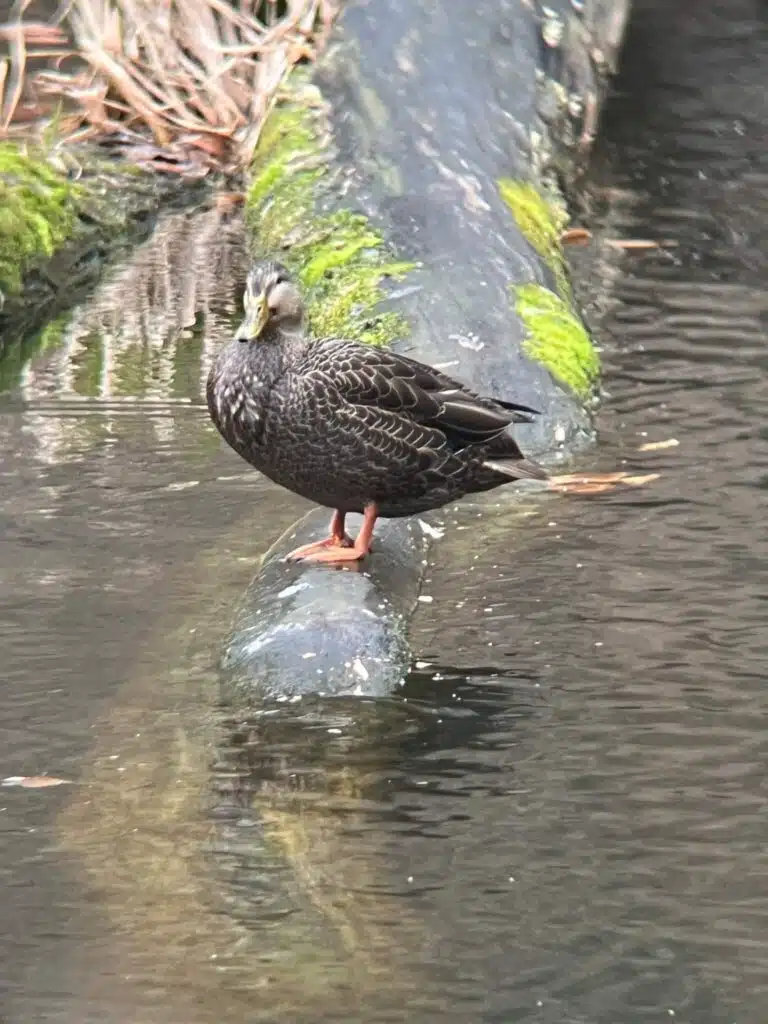
American Black Ducks (Anas rubripes) are among the most common types of mostly black ducks in North America.
Males and females of the species have a brown-black nuance with some females appearing almost completely black.
Different head and neck colors are also specific to this species. This includes a gray head and neck.
Another rare trait of these black ducks is their green beak color.
While both males and females have a black beak, there are slight nuanced differences between them.
Males have a yellow-green beak while females have a more uniform and plain green beak.
Blue patches in the central area of the wings also make these types of ducks stand out.
A species of North American freshwaters, these ducks may also move into estuaries.
Some of the most common locations of the species include the coastal areas of Eastern Canada and the US. They arrive here to overwinter in large numbers.
Plants and fishes are among its typical food choices.
Interesting fact – almost half of the American Duck population has declined over the past few decades.
Range – Northeastern North America
2. Surf Scoter
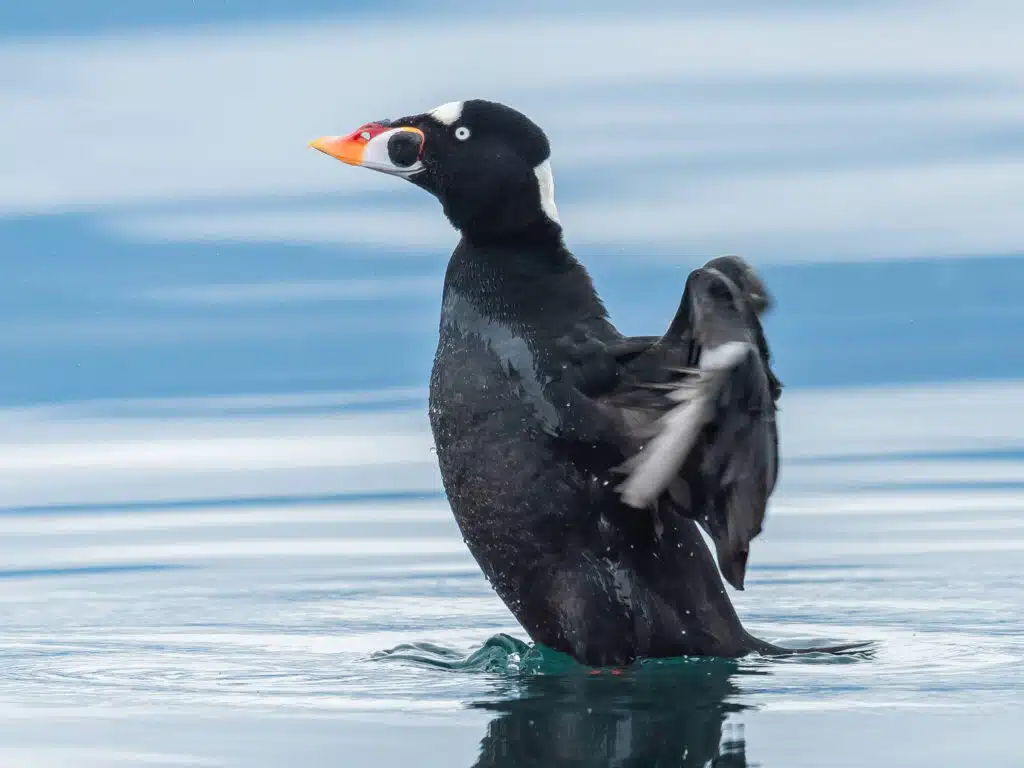
A species characterized by color differences between males and females. Surf Scoters (Melanitta perspicillata) are mostly known for their black plumage.
Mostly black color is specific to the males of the species. Male ducks have a black head, wings, neck, and belly with a colorful white patch behind the head.
Their beaks are also colorful, formed from orange, white, and black color patterns.
Females are dominated by gray-brown nuances with a black beak.
A type of sea bird in some of the Northernmost territories of North America, Surf Scoters inhabit areas of Alaska and Northern Canada.
As good flyers, these types of fucks move further South to overwinter. Some ducks simply move inland while others reach coastal US areas where they spend winters before returning to their breeding locations.
A species that goes through molting for its breeding plumage, Surf Scoters molt in mid-July.
This is also the period when they lose their capacity to fly and their direct response to potential predation with a quick escape.
Interesting fact – Surf Scoters can be spotted on inland reservoirs as backup habitats when the weather turns bad.
Range – Northern Canada, Alaska
3. Musk Duck
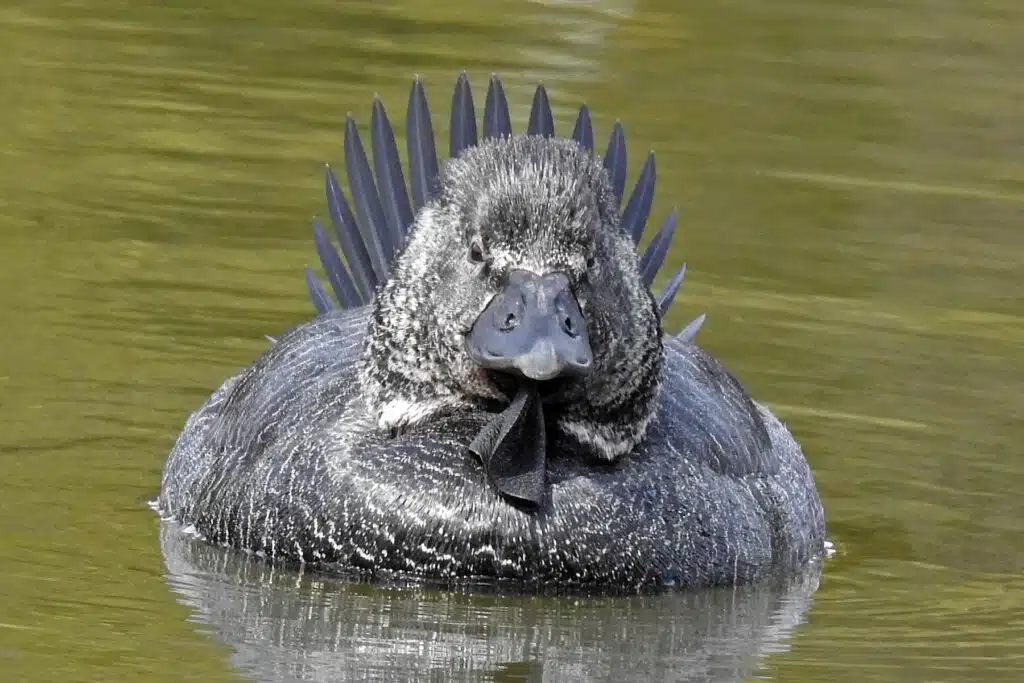
Mostly black coloring is specific to The Musk Duck (Biziura lobata). This is a species known for its very distinctive physical traits.
Some of these traits include having an almost freckled appearance with black species.
Males are mostly distinguishable through the large black galls on their necks.
Both the gall itself and the beak are also uniformly-black.
Musk Ducks are mostly specific to Australian lakes. It’s here that they are seen living in small numbers on some of the deepest lakes in their region.
Some of the best times to spot these types of ducks are during their breeding periods.
This is a long interval expanding a few months with peak activity in the Austral spring.
These types of ducks have stable populations across Australia as many are even found in protected natural habitats.
They present no interest in hunting as the ducks aren’t good to eat.
Interesting fact – the lobe skin on males is inflated during the courtship display.
Range – Western and Eastern Australia
4. White-winged Scoter
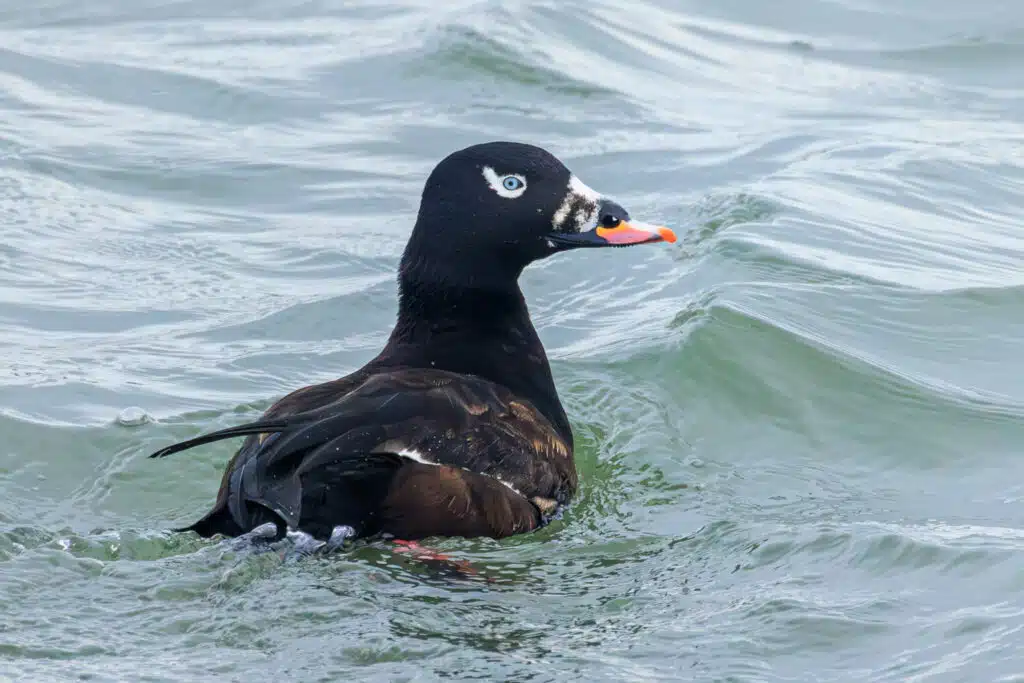
The name of this species of duck (Melanitta deglandi) is inspired by the white feathers of the males’ outer wings.
However, the male duck is mostly black. It only shows a few white patches along its outer wings as well as under the eyes.
A white streak runs under its eyes while the beak of the male is mostly orange.
Gray, black, and brown nuances are also seen in females.
As males, female White-winged Scoters have the same white section across their wing tips.
This is a species with specific behavioral choices such as forming a male and female bond long before the breeding season.
Males and females live in groups as they breed.
Other distinct habits include the movements between inland territories and coastal areas of Canada and The United States.
While they can breed inland, they may seek out coastal overwintering locations.
Interesting fact – males and females start courting early and migrate to their breeding sights together.
Range – Canada, Alaska, United States
5. Black Scoter
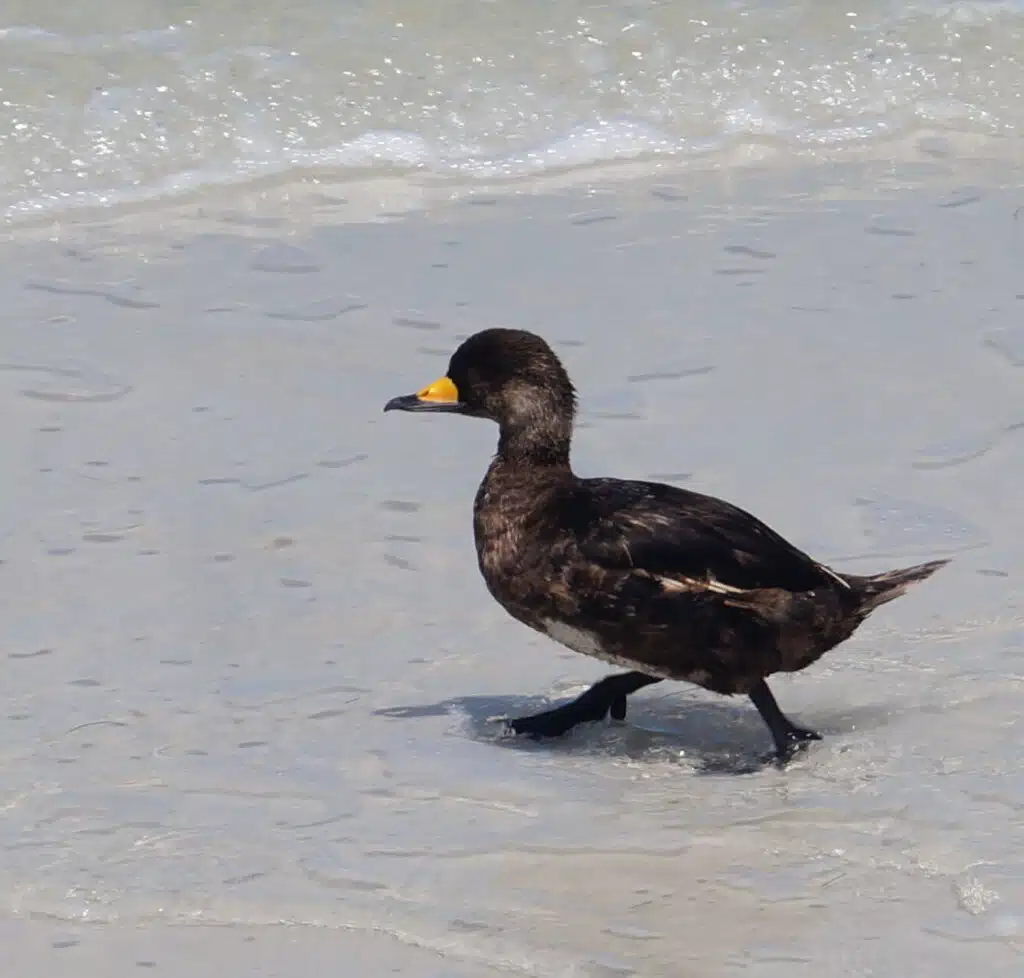
One of the Northernmost ducks of North America, Black Scoters (Melanitta americana) are known for their presence in Northern Canada and Alaska.
This is a species with a dark appearance, black in the case of males. All-black coloring is specific to males.
Females are mostly brown but also have a large bill. Males feature a black and orange beak.
Black Scoters are mostly found in North America. Some sightings have been confirmed in Europe.
However, clear species identification might be difficult outside of its breeding range.
Males are the most likely to be identified due to their distinct black colors as females look similar to other duck species.
Known divers, Black Scoters depend on oceans for food. They feed on crustaceans but they may also resort to other types of food such as insects.
A species that prefer coastal waters, Black Scoters require both shallow and deep waters in their ideal habitat.
In shallow water, these ducks are often seen diving and flapping their wings. They are highly present in the coastal waters of the Northeastern parts of North America.
While they live long lives, Black Scoter ducks aren’t as long-living as other species with a maximum lifespan of 10 years.
Interesting fact – Black Scoter ducks have been spotted on The Great Lakes.
Range – Northern North America
6. White-winged Scoter
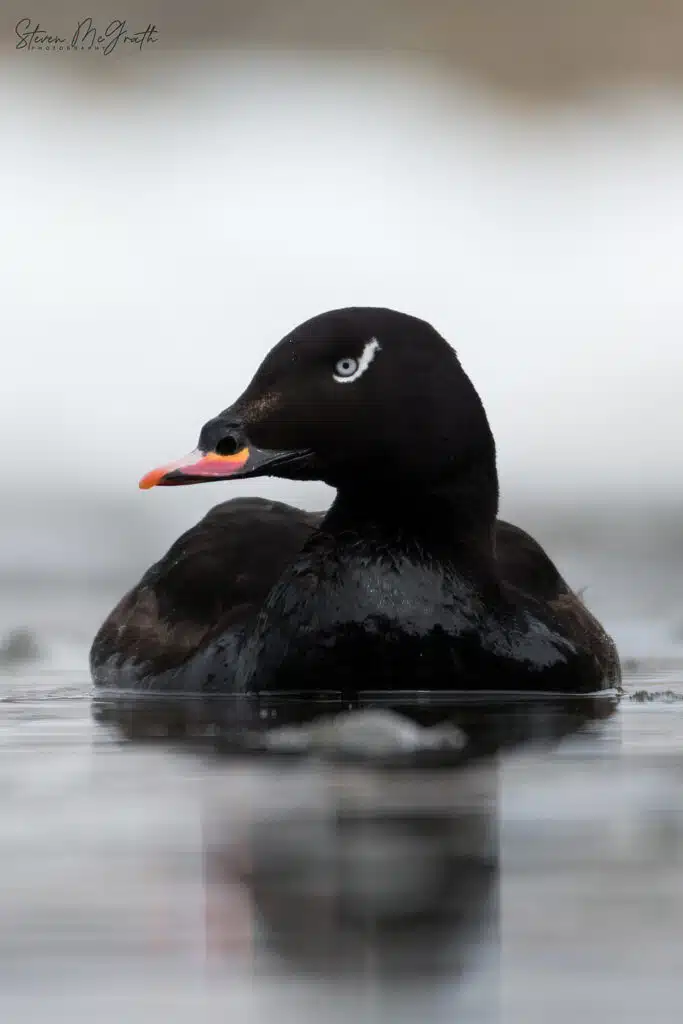
A species dominated by its black coloring, White-winged Scoters (Melanitta deglandi) are known for their rather dark appearance.
Only a few white areas are found around the eyes and on its wing flaps. Secondary feathers are also white on males while the females of the species are dark brown.
Females also show white wing flaps similar to those on male wings.
Other distinguishing traits of the black male include a yellow-orange beak plus its name itself, which means black duck in Greek.
This is a species with a widespread range across Alaska and Canada. This is a large breeding area but the duck also moves towards the coasts in the winter.
These movements or migrations also impact its feeding habits as it goes from freshwater to saltwater habitats.
From feeding on insects, the duck then starts to feed on small fish and crustaceans.
Interesting fact – A record-breaking longest-living White-winged Scoter has been confirmed to live 18 years.
Range – Alaska, Western Canada
7. Paradise Shelduck
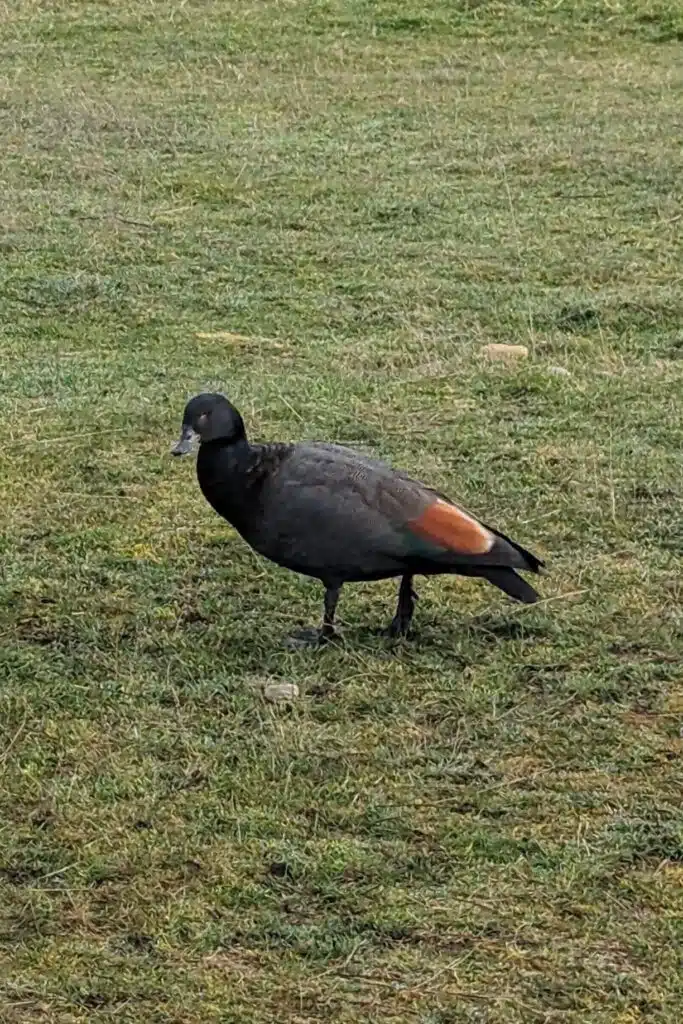
Paradise Shelducks (Tadorna variegata) are a species that may easily be taken as geese. These types of ducks are New Zealand natives and show black nuances in males.
Growing to a maximum size of 28 inches, male Paradise Shelducks have a black head and a black beak.
They show a dark brown chest and neck with black specks and gray, white, and black plumage across the back and belly.
Brown, white, and black patches are further distinguishable on their wings and flaps.
Females are more colorful but aren’t dominated by black nuances. They only share a black beak and black wing tips with males.
A white head is seen on females, together with brown-red wings.
These types of geese-like ducks reach their breeding maturity by the age of 3. Interestingly, they show breeding habits such as forming couples that last years or even for life.
Males and females can even communicate when taking care of their young.
This is done by both sexes but males are the ones to ring the alarm in case of trouble.
It has been shown that males are known to lower their heads when they uncover a predator in the area while females know to respond to their alerts by raising their heads.
These types of defensive mechanisms are also seen once the chicks arrive or even when the eggs aren’t yet hatched.
Interesting fact – pastures mark the favorite habitat of these ducks.
Range – New Zealand
8. Common Scoter
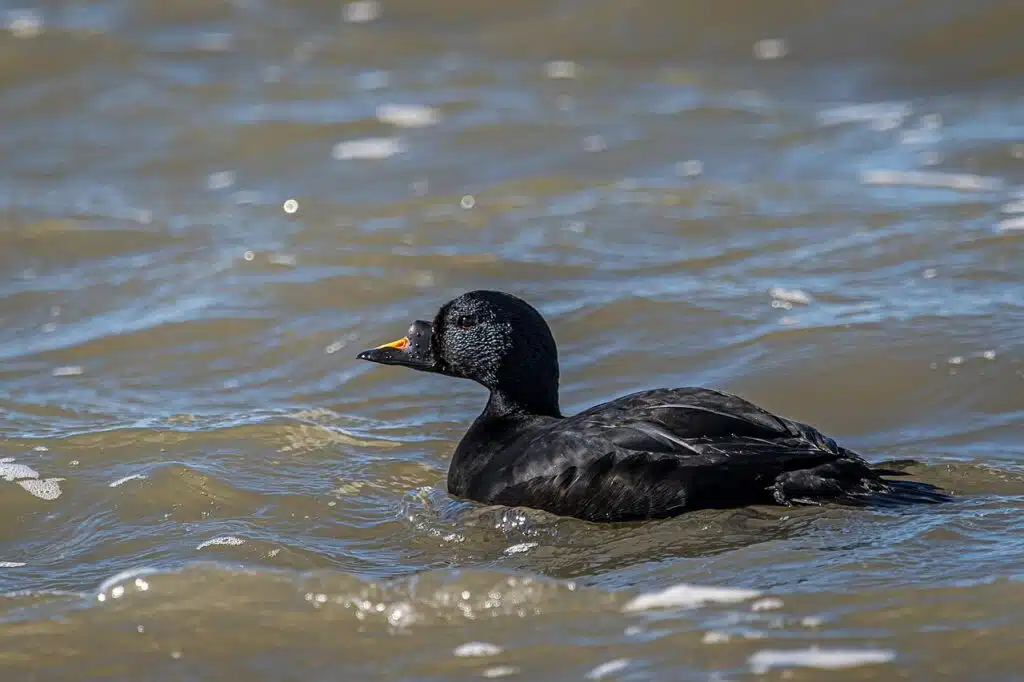
Male Common Scoters (Melanitta nigra) are known for being almost completely black. Their dark appearance is backed by a black beak which can sometimes show a colorful patch into the breeding period.
Yellow or orange nuances are among the most common when it comes to its beak coloration.
The duck doesn’t have any colorful contrasting patches on the head, wings, or body. Its all-black appearance is specifically known to make the species easy to identify.
Living in cool and temperate climates, Common Scoters are found in Scandinavia and Northern Asian territories around The Arctic.
Migration is possible with some of its populations which move slightly South, to the shores of Northern Europe where they overwinter.
These ducks are known divers and they live both on lakes and saltwater. From tundra to seas and oceans, they show the capacity to dive for food.
As with the feeding preferences of other ducks, Common Scoters are known to feed mostly on crustaceans and plants.
Interesting fact – more than 100.000 Common Scoters flock to The United Kingdom alone for overwintering.
Range – Europe, Asia
9. New Zealand Scaup
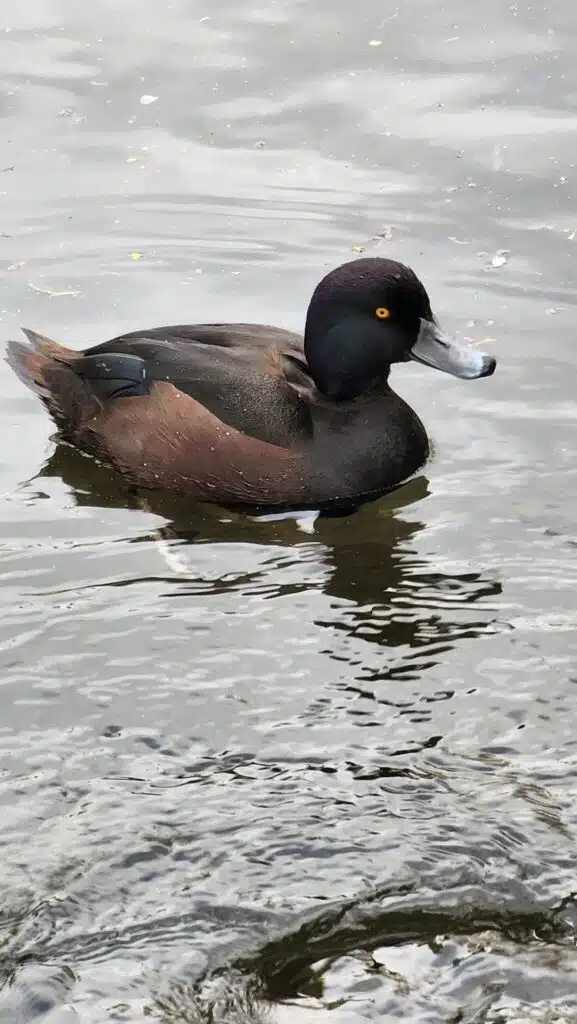
Smaller than other black ducks, The New Zealand Scaup (Aythya novaeseelandiae) only grows to a size of up to 16 inches.
This New Zealand duck has a dark appearance. Males are almost completely black with some small exceptions.
A green hue head is among these exceptions. This is a specific molt for the breeding period. Its gray beak is another exception to its otherwise black appearance.
Female New Zealand Scaups have a dark brown appearance with smaller black or dark brown sections along bright brown plumage.
These types of ducks are found both in freshwater and salt water.
As with most ducks, feeding and breeding are among their main concerns. These ducks have even adapted to feed on the foods other species find.
For example, other species might surface shrimp while the New Zealand Scaup moves in to take the prize.
While only found locally, the increasing regulation of natural ecosystems limits the number of predators in its range. This means the duck populations are on the rise.
Interesting fact – these ducks like to hide under willows and other trees.
Range – New Zealand
10. Velvet Scoter
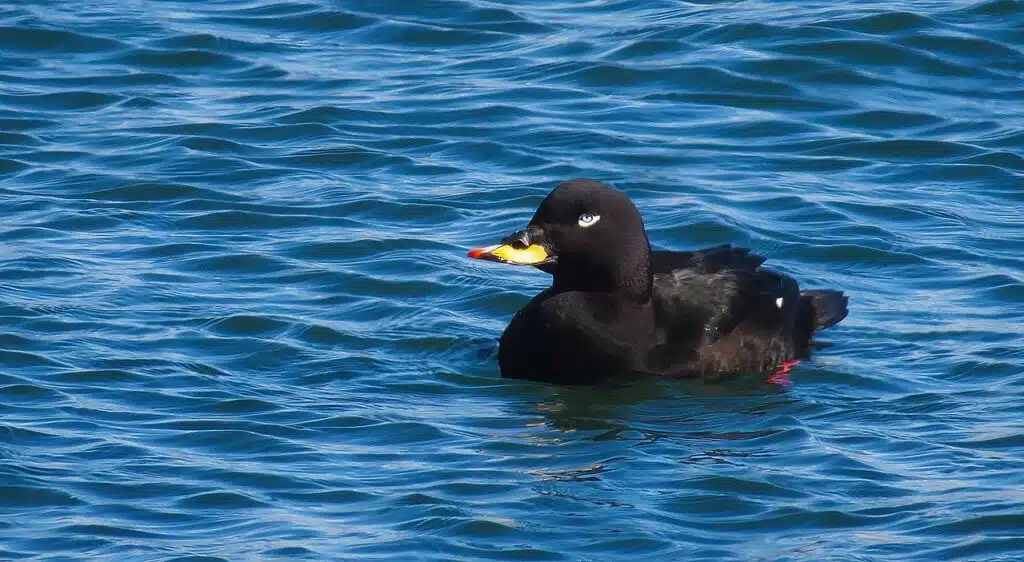
A species that dominates the seas of Europe, Velvet Scoters (Melanitta fusca) are Artic breeders.
Both males and females are dominated by black nuances, with males being almost completely black.
These types of birds are seen in Arctic regions in the summer. Males are identified by their black bodies heads, and wings.
A small white flap is seen on their wings while their beaks turn colorful for the breeding period.
Females are still dark, with a black head and brown-black feathers along the body and the wing.
The tips of female wings are also black.
Living in flocks, these birds are best observed when they migrate.
Migration routes differ from their populations which end up on the outskirts of Northern Europe or as far South as The Black Sea.
While these birds are almost black, they are known for laying large white eggs.
A typical clutch numbers up to 9 white eggs.
Interesting fact – these ducks fly in groups of perfectly aligned ducks.
Range – Northern Eurasia
11. African Black Duck
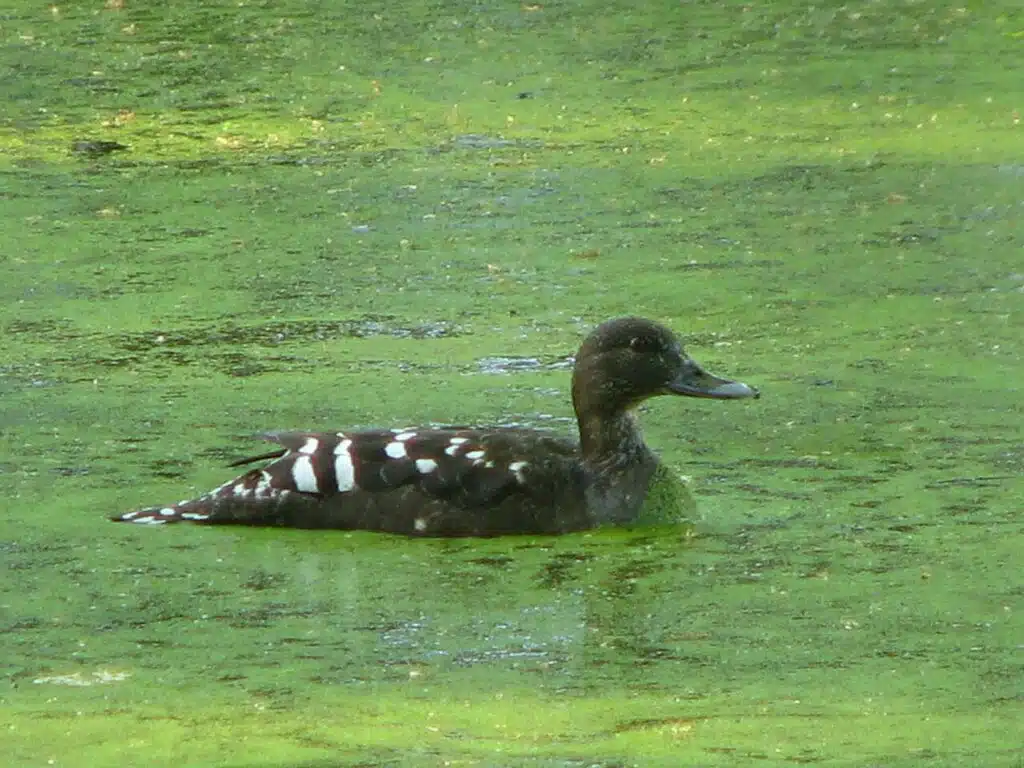
A species often seen along sub-Saharan rivers and larger streams, African Black Ducks (Anas sparsa) have a mostly black but contrasting appearance.
Its head is all-black, together with the beak. Black sections are seen on its neck, chest, and belly.
Its black wings show multiple white patterns which are combined with black and gray feathers.
On occasion, there are small blue, green, or purple patches along the wings as well.
This is one of the species that can breed at any moment around the year. This is why these colorful patches are seen on its wings throughout the year.
African Black Ducks are also known for their peculiar nesting habits. Females use all types of vegetation to build their nests just above water.
Up to 8 eggs are laid in a clutch and young ducks can easily move into water as this nest is located close.
Interesting fact – some of these ducks can live up to 30 years.
Range – Eastern sub-Saharan Africa
12. Stejneger’s Scoter
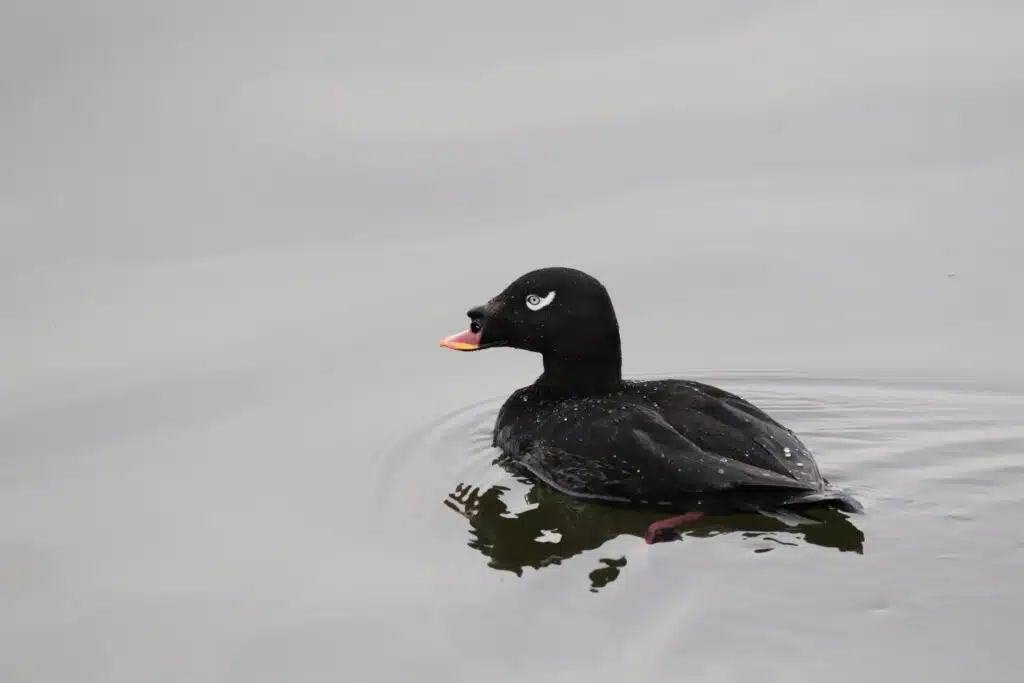
Black ducks of the world often inhabit Arctic regions and are rarely seen by humans due to their remote living.
This is also the case with the almost all-black Stenjneger’s Scoter (Melanitta stejnegeri).
Ducks of this family have almost completely black males. White sections around the eyes and wings are among the few bright sections on these ducks.
The bill of the male is also orange-red, contrasting its black appearance.
Found in Arctic regions, these types of ducks are also known as Siberian Ducks due to their Northern Russia territory presence.
They are also found near areas such as Northern Alaska, as visitors.
Large populations are found in China as the birds move South to overwinter.
Ducks of this species feed by diving. Mollusks and crustaceans are among their typical foods.
Interesting fact – this species has been spotted in Montana, its Southernmost North American habitat limit.
Range – Arctic regions, China
13. Muscovy Duck
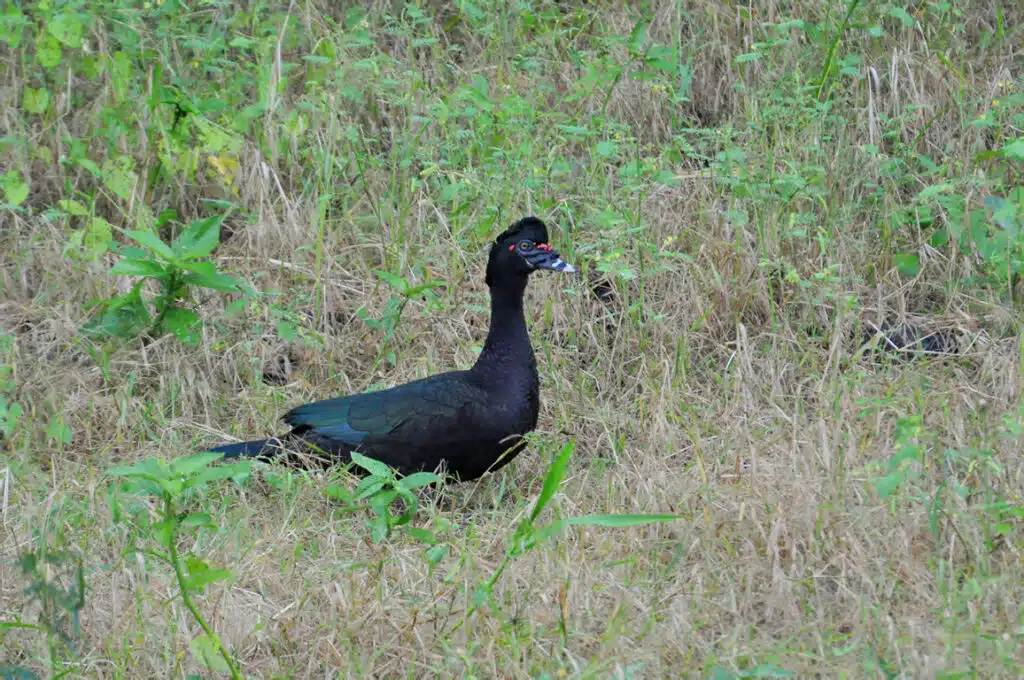
Considerable coloring differences can sometimes be seen between the males and the females of the same duck species.
Muscovy Ducks (Cairina moschata) also show considerable differences in their nuances.
These ducks are mostly black, but only in the case of males as females are white.
Males of the species can be all-black, black and white, or black and green.
Colorful patches are sometimes seen on the wings. They vary from white to metallic green or olive green nuances.
A red knob is also seen on the black head of males and females.
Females are mostly white but they still show a few large black spots around the body and the wings.
A species that is larger than other black ducks, Muscovy Ducks may grow to a size of just over 30 inches.
Their presence in North America is believed to be sporadic, but increasing.
Interesting fact – by some suggestions, this species is named after Moscow city.
Range – Central America, South America
14. East Indie
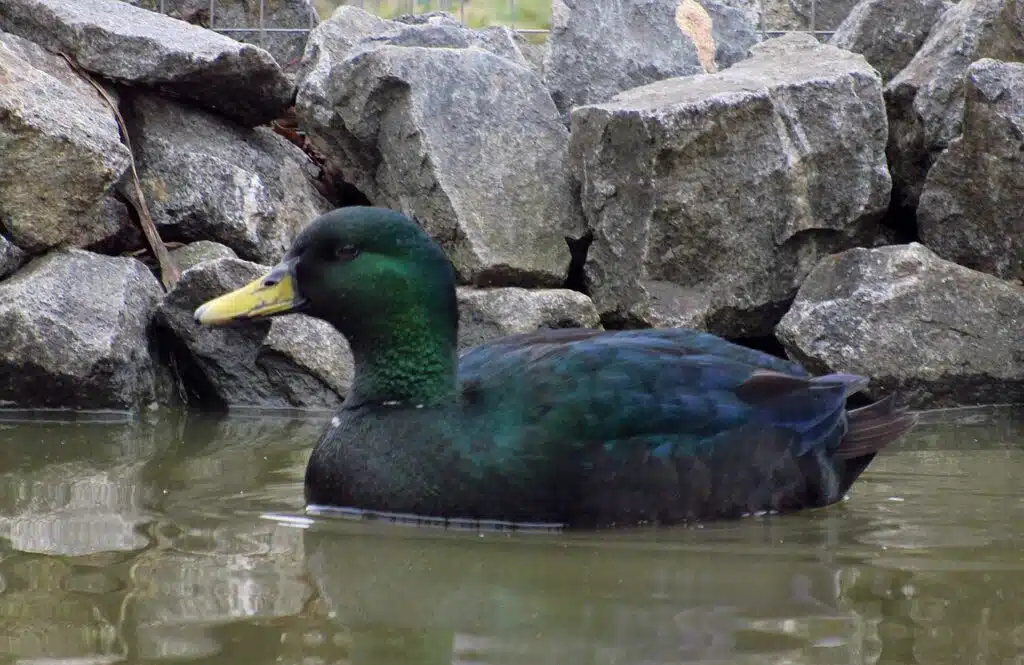
Some ducks are highly common but nobody knows their exact origin.
This is also the case of the common East Indie, a species that is predominantly black (females are gray).
By some anecdotes, these types of ducks have a North American origin. Other ideas suggest the species comes from South America.
Its introduction to Europe is believed to come from either North or South America.
These types of black ducks have different plumage to most other types of species.
While black, they show extensive green, blue, and purple hues. This type of iridescence is what initially drove its introduction around the world.
East Indies were initially known as decorative pond ducks in gardens. They were also appreciated for eating bugs and insects which would otherwise overtake gardens.
In some cases, the appearance of these ducks can change. For example, there are populations where males are mostly green as well as populations (older) where males also show white wing flaps.
Interesting fact – the ducklings of the species are all-black.
Range – United States, Brazil, Argentina
15. Swedish Blue

Some of the rearrest types of black ducks in the world are Swedish Blue Ducks. Males are mostly black or blue-black with a white neck and chest.
Females are mostly gray, with a gray head but a white chest and neck as seen on males.
These types of ducks may have been highly popular years ago when they were raised for meat and eggs.
It’s no wonder since females can lay almost 200 eggs per year.,
Swedish Blue ducks aren’t a species easily spotted in the wilderness today.
While they have many predators, these ducks are mostly targets for humans and end up being captured as decorative ducks.
Put on the list of species near extinction, these ducks are only present in low numbers in the wilderness.
It’s believed less than 100 adult Swedish Blue ducks remain in the wilderness today.
Their Northern European territory is cross-country, with most ducks being found in Northeast Germany.
Interesting fact – coastal areas in Northern Germany are believed to be the origin of the species.
Range – Germany, Sweden, Poland
16. Cayuga Duck
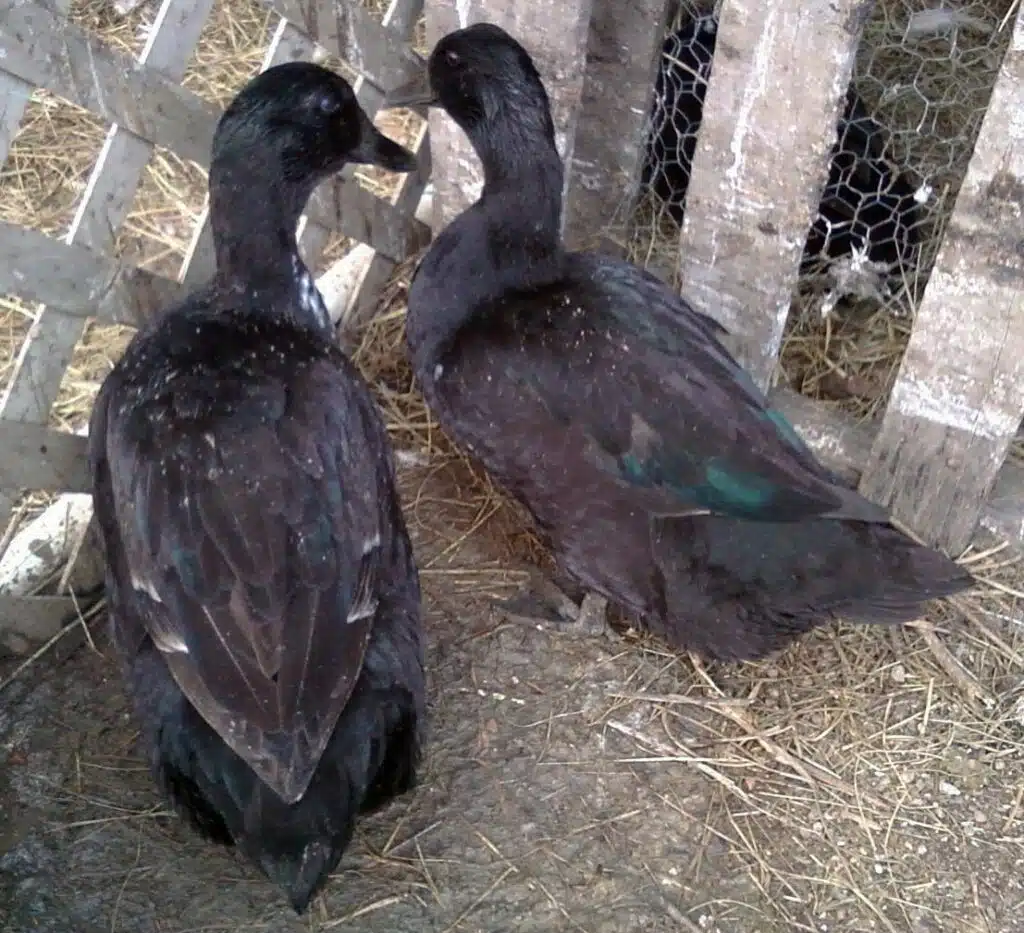
Cayuga Ducks are some of the most common ducks in North America and The United States.
This is a species known for its large size and heavy weight which is one of the reasons it used to be the most common meat duck on the continent.
In time, this has changed with the increasing populations of American Perkin.
Unlike white American Perkins, Cayuga Ducks have more complex coloring. Mostly black, these types of ducks have a green sheen to them which makes them look unique.
The head, neck, wings, and belly are all black with a green sheen. While an excellent duck for meat and eggs, Cayuga Duck coloring makes them an ideal choice as a decorative species as well.
The eggs of this species are just as colorful and spectacular as the ducks themselves.
Cayuga Duck egg coloring varies with the season. However, these might be among the few black duck eggs in the world.
Even more, the eggs can have a green tint when laid later in the egg-laying season.
Interesting fact – females can lay up to 150 eggs per year.
Range – United States
17. Pomeranian Duck
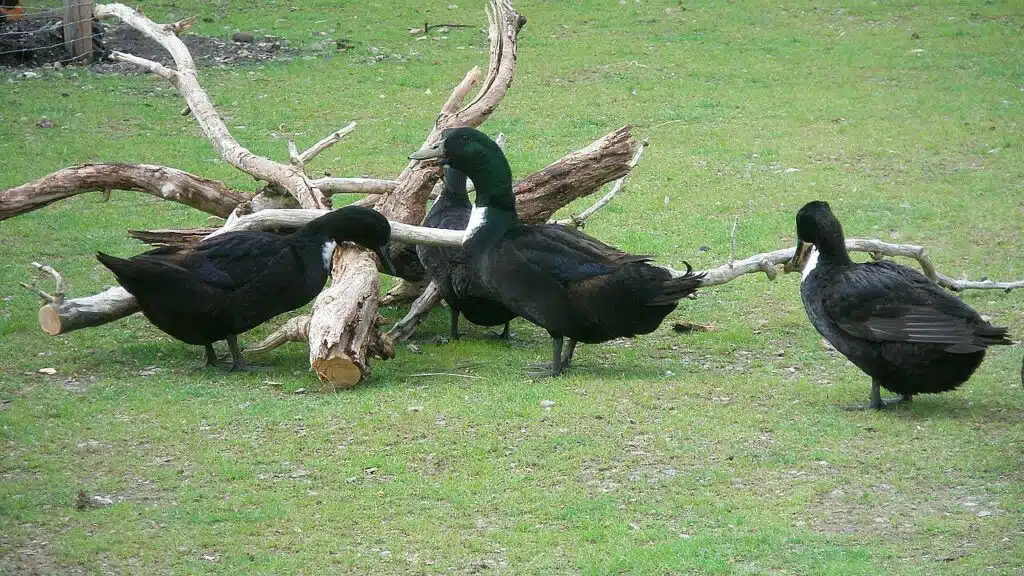
An almost all-black appearance is specific to these Northern European Ducks.
They are still found in the wilderness in small numbers and are known to resemble The Swedish Blue.
Black color is seen across the head, wings, and body of the species except for its white neck and chest.
Both males and females are black and even its variants are known to have charcoal-black coloring.
The production of eggs is lower as females of the species rarely lay more than 100 eggs per season.
Interesting fact – Pomeranian Ducks come from the same region of Germany as The Swedish Blue.
Range – Germany